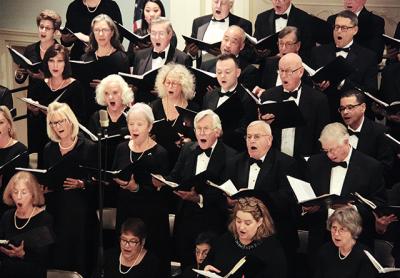Choral Society of the Hamptons: 'What Music-Making Should Be'

After hearing a performance of a motet by J.S. Bach, Mozart was heard to exclaim: “Now, here is something one can learn from!” Both composers were represented in a program presented recently at the Bridgehampton Presbyterian Church by the Choral Society of the Hamptons and the South Fork Chamber Ensemble. Anyone caring about choral music, and community choral music in particular, might have uttered a similar exclamation.
Under the baton of its longtime music director, Mark Mangini, the Choral Society, accompanied by an accomplished instrumental ensemble, performed a thoughtfully chosen program of seasonally thematic compositions offering both vocal and musical challenges. Engaging program notes by Mr. Mangini and Fred Volkmer added to the enjoyment of a large, diverse, and appreciative audience. This is what community music-making can and should be.
The afternoon began with a setting of “Hodie Christus Natus Est” by Heinrich Schütz, arguably Germany’s first great composer. It is joyful, optimistic music by a composer who lived and worked during the Thirty Years War, one of the darkest periods of German history. The singers not only did justice to the recurring, jubilant Alleluias, but, with clear direction from Mr. Mangini, smoothly navigated the kinds of changes in tempo and meter that plague many amateur choirs. From at least one seat in the house, the balance between singers and instrumentalists tilted rather heavily in favor of the players, but this did not detract much from the impact of the overall performance.
Although there is no direct evidence that he studied Schütz’s music, Johann Sebastian Bach was of the same musical lineage, so it was altogether fitting that the “Hodie” was followed by Bach’s K 61, “Nun komm, der Heiden Heiland,” written in 1714 for the first Sunday in Advent. In both the overture and the closing chorale, it was clear that the chorus benefited from careful attention to German diction in rehearsal.
In the overture, where each voice part sings the long notes of the melody alone against the dotted rhythms in the orchestra, some of the problems of having a high proportion of women singing tenor were exposed. The notes were present, but in that part of a woman’s vocal register they cannot be sung with the kind of authority called for by the text and musical setting. In fairness, though, that was the only moment where this was a glaring problem.
The three professional soloists, Rada Hastings, soprano, Nils Neubert, tenor, and Jason Eck, bass, acquitted themselves well, especially in the tenor recitative and the bass aria.
Henry Purcell’s “Behold, I Bring Glad Tidings” followed. This is largely a piece for soloists, one of whom, Carol Balodis, an alto, is a member of the Choral Society. Ms. Balodis did an outstanding job, more than holding her own vocally and musically with Mr. Neubert and Mr. Eck. The chorus made the most of its limited role, contrasting a beautifully soft “To God on high and on earth” with the exuberant “Glory!” that preceded it.
In a nifty bit of programming that quietly acknowledged the coincidence this year of Christmas Eve and the first night of Hanukkah, the Purcell, with its call for peace on earth, good will toward men, was followed by Hugo Weisgall’s “Evening Prayer for Peace.” The sentiments expressed in the two works may have been similar, but the “Prayer for Peace” was sung a capella, in Hebrew, and in a strikingly different harmonic language from anything earlier in the concert. Even without instrumental support, for the most part the chorus handled the melodic and harmonic challenges quite well. This short piece was followed by Weisgall’s “Fortress, Rock of Our Salvation.”
Performances of early compositions by musical prodigies often provide more of a curiosity than a satisfying musical experience, but this is not the case with the Missa Brevis in F, written when Mozart was just 18. There is unmistakable sophistication in this six-movement setting of the Mass. From the precision of the off-beat entrances in the Kyrie to the wonderfully subtle, dynamic inflections of the Gloria’s “Amen,” both singers and instrumentalists rose to the occasion at the end of their second performance of the day, recovering nicely from some slight ensemble issues in the Credo.
Among the most impressive aspects of the entire day was that all of the solos in the Mozart were sung by members of the Choral Society — Hannah Faye Huizing, Suzanne Nicoletti, Christine Cadarette, Joshua Huizing, and Thomas P. Milton were simply outstanding in the composer’s musically and vocally challenging solo lines. The future of the Choral Society is exceedingly bright with singers such as these leading the way.
Community choruses offer their own unique opportunities and challenges, and they require a musical director with a special blend of gifts to get the kind of results that a sellout audience was on hand to appreciate Sunday evening. This was indeed “something one could learn from.” And enjoy.
